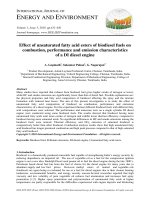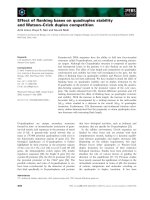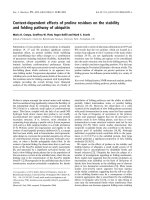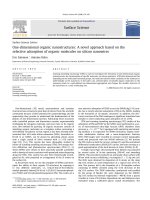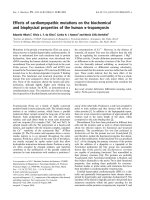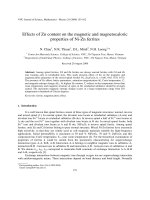Adsorption of toxic gases on graphene sio2 and graphene h BN
Bạn đang xem bản rút gọn của tài liệu. Xem và tải ngay bản đầy đủ của tài liệu tại đây (7.73 MB, 63 trang )
VIETNAM NATIONAL UNIVERSITY, HANOI
VIETNAM JAPAN UNIVERSITY
PHAM BA LICH
ADSORPTION OF TOXIC GASES ON
GRAPHENE/SiO2 AND GRAPHENE/h-BN
MASTER'S THESIS
VIETNAM NATIONAL UNIVERSITY, HANOI
VIETNAM JAPAN UNIVERSITY
__________________
PHAM BA LICH
ADSORPTION OF TOXIC GASES ON
GRAPHENE/SiO2 AND GRAPHENE/h-BN
MAJOR: NANOTECHNOLOGY
CODE: 8440140.11QTD
RESEARCH SUPERVISORS:
Dr. DINH VAN AN
Dr. PHUNG THI VIET BAC
Hanoi, 2020
ACKNOWLEDGEMENTS
I do thank to all people who helped me and supported me during the
completion of this report.
Foremost, I especially would love to express my hearty appreciation toward
Dr. Dinh Van An – my first supervisor and Dr. Phung Thi Viet Bac – my second
supervisor for their continuous support, conscientious guidance, wonderful
inspiration, and providing me with an excellent atmosphere during my thesis.
I would also like to acknowledge Prof. Morikawa Yoshitada, Assoc. Prof.
Ikutaro Hamada at Osaka University for their kind supports during my internship in
Japan. I am gratefully indebted to them for their very valuable comments and
supervision on this research topic.
My sincere thanks also go to Ms. Ta Thi Luong, Mr. Pham Trong Lam, and
Mr. Ngoc Thanh for their helpful instruction when learning how to use DFT and
VASP. I also want to thank other lab mates and lab secretaries for all their kind
supports.
Last but not least, I am grateful to staff of Vietnam Japan University, Osaka
University, and the Japanese International Cooperation Agency for their support with
kindness.
TABLE OF CONTENTS
Page
INTRODUCTION .......................................................................................................1
CHAPTER 1: LITERATURE REVIEW ....................................................................3
1.1. Graphene material ................................................................................................3
1.2. Heterostructure of Graphene/Hexagonal boron nitride (G/h-BN) .......................6
1.3. Heterostructure of Graphene/Silicon dioxide (G/SiO2) .......................................7
1.4. Gas molecules ......................................................................................................8
1.5. Physisorption mechanism of gas sensor.............................................................11
CHAPTER 2: COMPUTATIONAL METHODS AND MODELS .........................13
2.1. Density Functional Theory (DFT) .....................................................................13
2.2. The Kohn-Sham (KS) Method ...........................................................................14
2.3. The Local-Density Approximation (LDA) ........................................................17
2.4. VASP – Vienna Ab initio Simulation Package ..................................................18
2.5. Implemented computational scheme ..................................................................18
2.6. Heterostructure configurations ...........................................................................21
2.6.1. Unit cell of the graphene/substrate heterostructure.........................................21
2.6.1.1. G/h-BN heterostructure ................................................................................21
2.6.1.2. G/α-SiO2 heterostructure ..............................................................................22
2.6.2. Supercell of the graphene/substrate heterostructure .......................................23
2.6.2.1. G/h-BN heterostructure ................................................................................23
2.6.2.2. G/α-SiO2 heterostructure ..............................................................................27
2.6.3. Positions for adsorption of toxic gases on G/h-BN and G/α-SiO2 ..................28
CHAPTER 3: RESULTS AND DISCUSSION ........................................................30
3.1. Study and fabrication the Graphene/substrate heterostructures .........................30
3.1.1. The mismatch property between graphene and substrates ..............................30
3.1.1.1. G/h-BN heterostructure ................................................................................30
3.1.1.2. G/α-SiO2 heterostructure ..............................................................................31
3.2. Adsorption of different gases on Graphene/h-BN .............................................32
3.2.1. CO2 on graphene/h-BN ...................................................................................32
3.2.2. CO on graphene/h-BN.....................................................................................35
3.2.3. NO on graphene/h-BN ....................................................................................38
3.2.4. NO2 on graphene/h-BN ...................................................................................41
3.2.5. NH3 on graphene/h-BN ...................................................................................43
3.2.6. H2O on graphene/h-BN ...................................................................................45
3.2.7. Selectivity and sensitivity of gas adsorption on G/h-BN ................................47
3.3. Adsorption of CO and NO gases on Graphene/α-SiO2 ......................................49
CONCLUSIONS .......................................................................................................52
REFERENCES ..........................................................................................................53
LIST OF TABLES
Page
Table 1.1. Physical properties among graphite, SiO2, and h-BN ................................7
Table 2.1. The optimization results of AB stacking pattern with C on top B ...........24
Table 2.2. The optimization results of AB stacking pattern with C on top N ..........25
Table 3.1. Comparison of lattice mismatch with other articles ................................30
Table 3.2. Comparison with various DFT simulation methods ................................31
Table 3.3. Adsorption energy and adsorptive distance for CO2 on G/h-BN.............33
Table 3.4. Adsorption properties from optimization of CO/G/h-BN in four sites ....36
Table 3.5. Adsorption properties from optimization of NO/G/h-BN in four sites ...39
Table 3.6. Adsorption properties from optimization of NO2/G/h-BN in four sites ..41
Table 3.7. Adsorption properties from optimization of NH3/G/h-BN in four sites ..43
Table 3.8. Adsorption properties from optimization of H2O/G/h-BN in four sites ..45
Table 3.9. A comparison of adsorption energies of gases on G/h-BN .....................48
Table 3.10. A comparison of adsorption energies of gases on G/α-SiO2 .................50
LIST OF FIGURES
Page
Figure 1.1. Structure of monolayer of graphene and its applications .........................3
Figure 1.2. Structure and properties of other graphene’s derivatives .........................4
Figure 1.3. Structure and physical properties of other 2D materials ..........................5
Figure 1.4. Topology and charge density map of G/h-BN and G/SiO2 ......................5
Figure 1.5. Structure of h-BN .....................................................................................6
Figure 1.6. Configurations of (a) α-quartz and (b) cristobalite of SiO2 ......................8
Figure 1.7. Schematic mechanism of gas sensor and its signal measurement ..........11
Figure 2.1. Flow chart of the solution procedure of DFT .........................................13
Figure 2.2. Two different AB-stacking patterns of G/h-BN .....................................21
Figure 2.3. G/α-SiO2 heterostructure with (a) side view and (b) top view of G/SiO2
...................................................................................................................................23
Figure 2.4. Electron distribution of G/h-BN heterostructure with C on top B .........26
Figure 2.5. Band structure of G/h-BN and DOS of (a) h-BN, (b) graphene and (c)
total system................................................................................................................26
Figure 2.6. Optimized configuration and electronic density of G/α-SiO2 using
revPBE-vdW. (a) top view and (b) side view. Yellow in (c) presents the locations of
the electron cloud. .....................................................................................................28
Figure 2.7. Three adsorption sites and gas molecule orientations on G/h-BN .........29
Figure 2.8. Different adsorption sites on G/α-SiO2...................................................29
Figure 3.1. Atomic structures of all configurations for CO2 molecule adsorbed on
G/h-BN. (H: horizontal orientation, U: upright orientation; red ball: oxygen, brown
ball: carbon, blue ball: nitrogen) ...............................................................................32
Figure 3.2. Molecular orbital (MO) diagram of CO2 (1) and calculated DOS from
this study (2) ..............................................................................................................34
Figure 3.3. DOS of CO2 before and after adsorption on G/h-BN .............................34
Figure 3.4. Partial DOS of a carbon on graphene mainly interacted with CO2 before
and after adsorption ...................................................................................................35
Figure 3.5. Adsorption of CO molecule on G/h-BN in four different sites ..............36
Figure 3.6. Molecular orbital of CO (1) and DOS of CO before adsorption (2) ......37
Figure 3.7. DOS of CO before and after adsorption on G/h-BN ..............................38
Figure 3.8. Partial DOS of a carbon on graphene mainly interacted with CO before
and after adsorption ...................................................................................................38
Figure 3.9. Adsorption of NO molecule on G/h-BN in four different sites ..............39
Figure 3.10. MO of NO molecule (1) and DOS of NO before adsorption (2)..........40
Figure 3.11. DOS of NO before and after adsorption on G/h-BN ............................40
Figure 3.12. Adsorption of NO2 molecule on G/h-BN in four different sites ..........41
Figure 3.13. MO of NO2 molecule (1) and DOS of NO2 before adsorption (2) .......42
Figure 3.14. DOS of NO2 before and after adsorption on G/h-BN...........................42
Figure 3.15. Adsorption of NH3 molecule on G/h-BN .............................................43
Figure 3.16. MO of NH3 molecule (1) and DOS of NH3 before adsorption (2) .......44
Figure 3.17. DOS of NH3 before and after adsorption on G/h-BN...........................44
Figure 3.18. Adsorption of H2O molecule on G/h-BN in four different sites ..........45
Figure 3.19. MO of H2O molecule (1) and DOS of H2O before adsorption (2) .......46
Figure 3.20. DOS of H2O before and after adsorption on G/h-BN...........................46
Figure 3.21. Adsorption energy and distance of each gas on G/h-BN from z-axis
scanning .....................................................................................................................48
Figure 3.22. Adsorption of CO and NO on G/α-SiO2 in top and hollow sites .........50
LIST OF ABBREVIATIONS
2D
DFT
DOS
FET
G/h-BN
G/SiO2
HOMO
KS
LUMO
MO
VSEPR
vdW
Two-dimensional
Density Functional Theory
Density Of State
Field Effect Transistor
Graphene/hexagonal Boron Nitride
Graphene/Silicon Dioxide
Highest Occupied Molecular Orbitals
Kohn-Sham
Lowest Unoccupied Molecular Orbitals
Molecular Orbital
Valance Shell Electron Pair Repulsion theory
Van der Waals
INTRODUCTION
Recently, graphene, a two-dimensional (2D) monolayer of graphite, has drawn
a great interest in public due to its potential electrical properties. It can serve as a core
material in nano-electronic appliances. One of the most fascinating application of
carbon-based material such as graphene is in gas sensors detecting gases on the
atmosphere with a high sensitivity. Accordingly, the high mobility of carrier’s
behavior of graphene may provide essential clues for gas adsorption properties.
Current research efforts are mostly directed at the detection and remedy of air
pollution by anthropogenic activities. Nonetheless, an issue with the high sensitivity
of graphene with gas adsorption is that the selectivity in the study of gas adsorption
is quite questionable. Hence, for the purpose of enhancing the selectivity of gas
adsorption’s study, several novel approaches have been adopted by doping method,
structural defect method, or substrate introduction. In this study, the substrate
introduction on graphene is take into consideration to ameliorate the selectivity of
pristine graphene.
Heterostructure of graphene and a vdW interactive substrate has been studied
and reported such as a second graphene layer, MoS2, SiO2 or h-BN in order to open
band gap of graphene and help improve its electrical properties. It is demonstrated
that a considerable improvement in chemical stability of graphene supported on such
substrates. Therefore, hybrid structures of graphene with a substrate are of pivotal
importance for both theoretically fundamental studies as well as applications of
graphene.
Additionally, the booming of electrical waste disposal is a critical problem for
scientists and environmentalists. The manufacture of a variety of chemically singleuse gas sensors is one of typical examples of this. In order to solve that issue, the
physisorption of adsorbates is necessary for the gas adsorption mechanism.
Furthermore, the introduction of a substrate below graphene is still based on mainly
vdW interactions, so that graphene and substrate could be really promising for
achieving the requirement for green studies.
In this work, the adsorption of gases including five toxic gases CO2, CO, NO,
NO2, NH3, and water vapor H2O adopted for hygrometer (humidity sensor) on two
constructed heterostructures (G/h-BN and G/SiO2) were investigated on particular
sites (Top, Hollow, and Bridge). To fully understand the adsorption mechanism of
toxic gases on hybrid structures, DOS analysis was conducted. The aims here were
to (1) analyze the optimal positions in gas adsorption, (2) rationalize the adsorption
properties (adsorption energy and adsorptive distance) of gases on heterostructures,
(3) decipher the adsorption mechanism by exploiting DOS diagram and (4) analyze
the selectivity and sensitivity of constructed materials.
CHAPTER 1: LITERATURE REVIEW
1.1. Graphene material
Graphene, silicene, germanene, phosphorene, hexagonal boron nitride (h-BN),
molybdenum disulphide (MoS2), graphitic structures of carbon nitride (g-C3N4), and
zinc oxide (g-ZnO) [12] which are typical representatives of two-dimensional (2D)
ultrathin materials have recently exploited on a wide range of applications such as
electrical appliances. As far as graphene was concerned, a 2D sp2-bonded carbon
monolayer, has drawn tremendous attention owing to its notable electronic and
mechanical properties [14]. It is known to have remarkable electronic properties, such
as a high carrier mobility [8][19], but the absence of a band gap restricts its
applications of large-off current and high on-off ratio for graphene-based electronic
devices [14]. Fig. 1.1 illustrates the structure of monolayer of graphene and its
applications [23].
Figure 1.1. Structure of monolayer of graphene and its applications
Initially, it was believed before the accomplishment of experimental
fabrication of graphene that strict 2D crystals could be difficult to stabilize from
3
theoretical and experimental perspectives due to the effects of thermal expansion.
Nevertheless, in 2004, a single layer of carbon in atoms-level thickness was fabricated
by Geim and Novoselov using micromechanical exfoliation and studied the electronic
field effect and carried out a series of studies [8].
On the other hand, graphene oxide and its reduced form are graphene’s
derivatives and are all semiconductors but with lower carrier mobility (Fig. 1.2) [24].
Figure 1.2. Structure and properties of other graphene’s derivatives
In comparison with other 2D materials (Fig. 1.3) [12], graphene is considered
to be an excellent sensor material with high conductivity, electron mobility and the
gapless and approximately linear electron dispersion around the Fermi level.
Although graphene exhibits a very promising material with excellent electronic
properties, there will be quite questionable to adopt graphene into sensors using nanoelectric devices [19]. Therefore, the introduction of the substrates such as h-BN and
SiO2 can be an innovative way to help open up the band gap of graphene, thereby
enhancing the sensor properties of graphene.
4
Figure 1.3. Structure and physical properties of other 2D materials
Figure 1.4. Topology and charge density map of G/h-BN and G/SiO2
A comparison of topology of G/h-BN and G/SiO2 is depicted in Fig. 1.4
[17][29]. It is clear that while a similar lattice structure of graphene with both h-BN
and SiO2 is seen, h-BN seems to have a smooth surface without any charge traps and
5
SiO2 surface is usually impure and uneven. The surface optical phonon energy of hBN is two-fold magnitude greater than that of SiO2 [4]. It indicates that G/h-BN will
have a better performance compared with G/SiO2.
1.2. Heterostructure of Graphene/Hexagonal boron nitride (G/h-BN)
Hexagonal boron nitride (h-BN) is a representative of 2D material with a wide
band gap. Hexagonal boron nitride (h-BN) is called “white graphene”, consists of
alternative boron and nitrogen atoms in a sp2-hybridized 2D honeycomb arrangement
and 2D h-BN monolayer is isolated from bulk BN (Fig. 1.5) [6]. The bond length of
B-N is around 1.45Å. The interaction between boron and nitrogen is basically a
covalent bond.
Figure 1.5. Structure of h-BN
Due to the fact that hexagonal boron nitride (h-BN) has a wide band gap, it
could lead to its excellent properties of electrical insulations, high thermal
conductivity and superior lubricant properties [28]. Additionally, it can be useful as
an important complementary 2D dielectric substrate for graphene electronics. A
direct band gap of h-BN which is the gap between HOMO and LUMO levels is
attained by π and π∗ located on the N atom and B nucleus, respectively [9].
6
Dean et al. studied the quantum Hall effect of graphene with h-BN substrate
for the first time in 2011 [7]. Wang et al. conducted the combination of graphene and
h-BN crystals by physical force [26]. Later on, other researchers have investigated
and proposed G/h-BN heterostructure functional devices. G/h-BN heterostructure can
act as a high-capacity cathodes with high voltage for Aluminum batteries in the study
of Pretti Bhauriyal et al. [3]. Furthermore, gas sensing properties has been studied for
2D G/h-BN lateral interface, specifically for NOx gas in Paquin et al. studies [21].
1.3. Heterostructure of Graphene/Silicon dioxide (G/SiO2)
Table 1.1. Physical properties among graphite, SiO2, and h-BN
Lattice constant
Thermal
conductivity
(Wm-1K-1)
Dielectric
constant
SiO2
Graphite
Graphite
diamond
0.3567
h-BN
Orthogonal
a =1.383 Å, b = 1.741
Å, c = 0.504 Å
Face-centered 1.936
1.4
a=b=
2.46Å
c = 6.67Å
25-470
22
25.1
3.9
8.7
5.7
4
a=b=
2.502Å;
c = 6.61 Å
First of all, SiO2 is known as nano-silica and has been used for a great deal of
biomedical research owing to its functionalized ability and stability. Furthermore,
SiO2 substrate was widely applied on integrated circuits working as a dielectric
medium. It is explained by the good physical properties of SiO2 (Table 1.1) [10]. For
graphene supported by SiO2, Ishigami et al. [13] indicated that single layer graphene
mainly follows the underlying morphology of SiO2 and estimated the adhesion energy
between graphene and SiO2. Otherwise, DFT calculations of graphene on SiO2
surface have been published. Whilst SiO2 is generally experimentally found in
amorphous, DFT calculation typically limited to crystalline SiO2 structures. There are
two kinds of SiO2 represented in Fig. 1.6 [8].
They are α-quartz and cristobalite with multiple layers of SiO2. In reality, αquartz is the most stable configuration under ambient conditions. X F Fan et al. [8]
has studied the interaction between graphene and the surface of SiO2 in both α-quartz
7
and cristobalite using first principles DFT. It is found that by applying oxygen defect,
the SiO2 surface could shift the Fermi level of graphene. Nguyen et al. [20] has also
studied oxygen-terminated SiO2 (0001) surface interacted with graphene and
concluded that G/SiO2 is a semiconductor. Furthermore, Zhimin Ao et al. [2] has also
worked with G/α-SiO2 (0001) for interaction study and concluded that the vdW forces
mainly serves as the interacting force in this system and is stronger than interaction
of graphene layers in graphite.
(a)
(b)
Figure 1.6. Configurations of (a) α-quartz and (b) cristobalite of SiO2
On the other hand, the studies of gas adsorption on G/h-BN and G/α-SiO2 are
still limited and the gas adsorption mechanism is still a questionable problem for these
systems even there have been a lot of studied investigating the gas adsorption on
pristine graphene. Hence, the significance of depicting the gas adsorption has
motivated us to study more deeply in these heterostructures.
1.4. Gas molecules
These days, the process of industrialization and urbanization are booming
sharply, one of the most pressing problem worldwide is air pollution. As a result, the
detrimental effect of this serious phenomenon is that it can be linked to the damage
of human health in a direct or indirect way. As WHO data reported, air pollution
could cause 1 in 9 deaths worldwide while ambient air pollution caused 7.6% deaths
8
over the world in 2016 [27]. It is estimated that 4.2 million premature deaths
universally are associated to the pollution of atmosphere [1]. It mainly causes some
serious health problem related to breathing such as lung cancer, and acute respiratory
infections in children as well as heart disease, stroke, chronic obstructive pulmonary
disease, etc. For the purpose of mitigating the impacts of air pollution, the detection
of toxic gases on air with a good sensitivity and favorable selectivity plays an
essential role in research and manufacturing process. Thus, this study aims to discover
and propose promising materials that can not only be economical but also produce a
better sensitivity and selectivity with toxic gases in the air. The mechanism of gas
adsorption is also one of the aspects drawing a lot of interest for understanding the
interaction of material and gas adsorbate.
In reality, outdoor air pollution can root from natural and anthropogenic
sources. Regarding natural sources, the contribution of local air pollution is more
prone to forest fires and dust storms [1]. On the other hand, human activities are the
key factor leading to polluted air problems and far exceeds natural sources. Adverse
health consequences of air pollution can occur as a result of short- or long-term
exposure [27]. Herein, we investigate the adsorbability of 5 pollutants (CO2, CO, NO,
NO2, NH3) which have strong impacts on human health as well as the earth climate
i.e. global warming and water vapor H2O acting as an essential element in air. There
are some physical properties and toxicity of 5 toxic gases and water vapor below:
a) Carbon dioxide (CO2): CO2 gas is colorless gas and is called “greenhouse gas” due
to its main contribution into greenhouse effect. CO2 is naturally traced in the Earth’s
atmosphere and could be released from the dissolution of carbonate rocks in water
and acids. It is a by-product of burning fossil fuels and land-use changes and other
industrial processes. In geometric aspect, CO2 is a linear molecule with sp
hybridization, with the bond length of C=O is 1.163 Å.
b) Carbon monoxide (CO): CO is a colorless and odorless gas, which at high levels
can be harmful to humans by binding with hemoglobin, so it will be easily absorbed
through the lungs. That leads to hypoxic injury, nervous system damage, and even
9
death. The dizziness and nausea phenomenon are recognized in 45-min exposure of
CO. The origin of CO in the atmosphere is believed coming from the exhaust of
transport activities and machinery that burn fossil fuels. According to VSEPR, CO
has a linear molecular shape and the bond length of CO is originally 1.128 Å. The
hybridization of CO is sp with the bond order of 3. CO is a diamagnetic molecule
with fully paired electrons.
c) Nitrogen monoxide (NO): There is a natural spontaneous reaction transforming NO
in the atmosphere environment into NO2 during oxidation process. Generally,
nitrogen oxides are mainly produced from natural phenomenon such as lightning in
thunderstorms. NO gas is a colorless gas and is a main factor in acid rain deposition.
Some common symptoms with breathing of low levels of NO are cough, tiredness,
and nausea. Nonetheless, NO can damage seriously our lung over the next one to two
5
days after breathing. Basically, NO has 1.15 Å of bond length and bond order is .
NO is a paramagnetic molecule with one unpaired electron.
2
d) Nitrogen dioxide (NO2): NO2 is a reddish-brown gas with origin from motorvehicle emissions. The shape of NO2 molecule is bent. Due to acute toxicity of NO2,
NO2 has a serious harm to health like chlorine and CO gases in equal measure. It can
be directly adsorbed through human lungs and its inhalation, then cause heart failure
and even to death. NO2 is also a paramagnetic molecule with single unpaired electron.
The bonding angle of NO2 is 134.3o with 1.197 Å of bond length.
e) Ammonia (NH3): Ammonia is a colorless alkaline gas with a characteristic of
pungent smell. Ammonia is considered as one of the abundant nitrogen-based
substances in the air. Breathing over the threshold of concentration of NH3 can expose
to sinusitis, upper airway irritation, and eye irritation. Some diseases of the lower
10
airways and interstitial lung are found as acute exposures occur to concentrated
ammonia [27]. The bond length of N-H is 1.017 Å. Geometrically, NH3 has one lone
pair of electrons and has a tetrahedral structure in sp3 hybridization.
f) Water vapor (H2O): The bond length of O-H in water vapor is 0.9584 Å. According
to VSEPR, H2O is in a bent shape with sp3 hybridization. Geometrically, H2O has
two lone pairs of electrons. In this study, H2O is in gas phase and is not classified as
a toxic gas. Nonetheless, H2O serves as an indispensable factor in air, so it can be as
a reference for other toxic gases studies. Apart from investigating the toxic gas
adsorption on constructed heterostructures, the study on adsorption of water vapor
could be adopted for hygrometer.
1.5. Physisorption mechanism of gas sensor
Figure 1.7. Schematic mechanism of gas sensor and its signal measurement
Toward developing gas sensor materials, the mechanism for physisorption is
taken into account. Therefore, the rationale of signal measurement plays an essential
role in understanding it (Fig. 1.7). Basically, there are three phases that physisorption
11
has occurred during detection (Fig. 1.7a). The first stage is the stage before gas
adsorption (1). The gas molecule is in the proximity of the surface of sensor and there
has not been any interaction yet. Then, the second stage is the stage being completely
adsorbed on surface of sensor material (2). This is the time that the gas molecule is
close enough to interact with surface of material and the interaction of gas and sensor
fully achieved the most preferable positions for adsorption. After being completely
adsorbed on sensor, the gas turns to desorption stage (3). The adsorption process will
last for several seconds.
From practical aspect, the signal measurement of gas sensor can be estimated
by impedance measurement. It is based on the change of resistance (R). Due to ntype nature of graphene, if the gas molecule serves as an acceptor which gains
electron from sensor material, the signal of resistance will immediately increase and
reach a peak during being completely adsorbed and vice versa (Fig. 1.7b). In
desorption phase, the value of resistance will suddenly come back the initial value
due to the fact that there is not any interaction between gas molecule and surface. For
each adsorption, the response of sensor will get a peak of resistance during a contact
time. If the sensor is well qualified, the response should get the same height and wide
of the peak at each different adsorption.
12
CHAPTER 2: COMPUTATIONAL METHODS AND MODELS
2.1. Density Functional Theory (DFT)
Density Functional Theory (DFT) is a computational quantum mechanical
modelling method applied for natural and materials sciences in order to study the
electronic structure of many-body systems. In 1964, Pierre Hohenberg and Walter
Kohn proved that for molecules with a nondegenerate ground state, the ground-state
molecular energy, wave function, and all other molecular electronic properties are
uniquely determined by the ground-state electron probability density ρ0 (x, y, z), a
function of only three variables [16].
Hohenberg and Kohn proved their theorems only for nondegenerate ground
states. Subsequently, Levy proved the theorems for degenerate ground states [16].
The procedure of DFT can be summarized as in the below diagram [30].
Figure 2.1. Flow chart of the solution procedure of DFT
13
2.2. The Kohn-Sham (KS) Method
If we know the ground-state electron density ρ0 (𝐫) , the Hohenberg-Kohn
theorem tells us that it is possibe in principle to calculate all the ground-state
molecular properties from ρ0 without having to find the molecular wave function.
The Hohenberg-Kohn theorem does not tell us how to calculate E0 from ρ0 , nor does
it tell us how to find ρ0 without first finding the wave function. A key step toward
these goals was taken in 1965 when Kohn and Sham devised a practical method for
finding ρ0 and for finding E0 from ρ0 . Their method is capable, in principle, of
yielding exact results, but because the equations of KS method contain an unknown
functional that must be approximated, the KS formulation of DFT yields approximate
results [16].
Kohn and Sham considered a fictitious reference system (denoted by the
subscript s and often called the noninteracting system) of n noninteracting electrons
that each experience the same external potential-energy function νs (𝐫i ), where νs (𝐫i )
is such as to make the ground-state electron probability density ρs (𝐫) of the reference
system equal to the extact ground-state electron density ρ0 (𝐫) of the molecule we are
interested in; ρs (𝐫) = ρ0 (𝐫). Since Hohenberg and Kohn proved that the groundstate probability-density function determines the external potential, once ρs (𝐫) is
defined for the reference system, the external potential νs (𝐫i ) in the reference system
is uniquely determined, although we might not know how to actually find it. The
electrons do not interact with one another in the reference system, so the Hamiltonian
of the reference system is
n
n
i=1
i=1
1
̂ s = ∑ [− ∇2i + νs (𝐫i )] = ∑ ĥKS
H
i
2
ĥKS
i is the one-electron Kohn-Sham Hamiltonian.
Since the reference system s consists of noninteracting particles, the ground-
state wave function ψs,0 of the reference system is the Slater determinant of the
lowest-energy Kohn-Sham spin-orbitals uKS
i of the reference system
KS
KS
KS
ψs,0 = |u1KS uKS
2 … un |, ui = θi (𝐫i )σi
14
̅ be
Kohn and Sham rewrote the Hohenberg-Kohn equation as follows. Let ΔT
defined by
̅[ρ] ≔ T
̅[ρ] − T
̅s [ρ]
ΔT
̅ is the difference in the average ground-state electronic kinetic energy between the
ΔT
molecule and the refence system of noninteracting electrons with electron density
equal to that in the molecule. Let
1
ρ(𝐫 )ρ(𝐫2 )
̅ee [ρ] ≔ V
̅ee [ρ] − ∬ 1
ΔV
d𝐫1 d𝐫2
2
r12
The Hohenberg-Kohn equation now becomes
1
ρ(𝐫 )ρ(𝐫2 )
̅s [ρ] + ∬ 1
̅[ρ] + ΔV
̅ee [ρ]
Eν [ρ] = ∫ ρ(𝐫)ν(𝐫)d𝐫 + T
d𝐫1 d𝐫2 + ΔT
2
r12
̅ and ΔV
̅ee are unknown. Defining the exchange-correlation
The functionals ΔT
̅[ρ] + ΔV
̅ee [ρ], we have
energy functional Exc [ρ] ≔ ΔT
1
ρ(𝐫 )ρ(𝐫2 )
̅s [ρ] + ∬ 1
E0 = Eν [ρ] = ∫ ρ(𝐫)ν(𝐫)d𝐫 + T
d𝐫1 d𝐫2 + Exc [ρ]
2
r12
This formula expresses Eν [ρ] in terms of three quantities, the first three terms
on the right side, that are easy to evaluate from ρ and that include the main
contributions to the ground-state energy, plus a fourth quantity Exc , which, though
not easy to evaluate accurately, will be a relatively small term. They key to accurate
KS DFT calculation of molecular properties is to get a good approximation to Exc .
The electronic energy including nuclear repulsion is found by addition of the
internuclear repulsion [16].
The Kohn-Sham orbitals are found as follows. The Hohenberg-Kohn
variational theorem tells us that we can find the ground-state energy by varying ρ
(subject to the constraint ∫ ρ d𝐫 = n ) so as to minimize the functional Eν [ρ] .
Equivalently, instead of varying ρ, we can vary the KS orbitals θKS
i , which determine
ρ. In doing so, we must constrain the θKS
i ’s to be orthonormal, since orthonormality
̅s .
was assumed when we evaluated T
One can show that the Kohn-Sham orbitals that minimize the energy for the
molecular ground-state energy satisfy
1
Zα
ρ(𝐫2 )
KS KS
[− ∇12 − ∑
+∫
d𝐫2 + νxc (1)] θKS
i (1) = εi θi (1)
2
r1α
r12
a
15
where the exchange-correlation potential νxc is found as the functional derivative
δE/δρ of the exchange-correlation energy Exc :
νxc (𝐫) ≔
δExc [ρ(𝐫)]
δρ(𝐫)
If Exc [ρ] is known, its functional derivative is readily found from the above formula,
and so νxc is known.
There is only one problem in using the Kohn-Sham method to find ρ and E0 .
No one knows what the correct functional Exc [ρ] is. Therefore, both Exc in the energy
expression and νxc are unonwn. Various approximations to Exc will be discussed
shortly [16].
The Kohn-Sham orbitals θKS
i are orbitals for the fictitious reference system of
noninteracting electrons, so, strictly speaking, these orbitals have no physical
significance other than in allowing the exact molecular ground-state ρ to be
calculated. The density-fucntional molecular wave function is not a Slater
determinant of spin-orbitals. In fact, there is no density-functional molecular wave
function. However, in practice, one finds that the occupied Kohn-Sham orbitals
resemble molecular orbitals calculated by the Hartree-Fock method, and the KohnSham orbitals can be used (just as Hartree-Fock MOs are used) in qualitative MO
discussions of molecular properties and reactivities. Note that, strictly speaking,
Hartree-Fock orbitals also have no physical reality, since they refer to a fictitious
model system in which each electron experiences some sort of average field of the
other electrons [16].
For a closed-shell molecule, each Hartree-Fock occupied-orbital energy is a
good approximation to the negative of the energy needed to remove and electron from
that orbital (Koopmans’ theorem). However, this is not true for Kohn-Sham orbitals
energies. The one exception is εKS
i for the highest-occupied KS orbital, which can be
proved to be equal to minus the molecular ionization energy. With the currently used
approximations to Exc , ionization energies calculated from KS highest-occupiedorbital energies agree poorly with experiment [16].
Various approximate functionals Exc [ρ] are used in molecular DFT
calculations. To study the accuracy of an approximate Exc [ρ], one uses it in DFT
calculations and compares calculated molecular properties with experimental ones.
16
The lack of a systematic procedure for improving Exc [ρ] and hence improving
calculated molecular properties is the main drawback of the DFT method [16].
In a “true” density-functional theory, one would deal with only the electron
density (a function of three variables) and not with orbitals and would search directly
for the density that minimizes Eν [ρ] . Because the functional Eν is unknown, one
instead uses the Kohn-Sham method, which calculated an orbital for each electron.
Thus, the KS method represents something of a compromise with the original goals
of DFT [16].
2.3. The Local-Density Approximation (LDA)
Hohenberg and Kohn showed that if ρ varies extremely slowly with position,
then Exc [ρ] is accurately given by
LDA [ ]
Exc
ρ = ∫ ρ(𝐫)εxc (ρ) d𝐫
where εxc (ρ) is the exchange plus correlation energy per electron in a homogeneous
electron gas with electron density ρ.
Jellium is a hypothetical electrically neutral, infinite-volume system
consisting of an infinite number of interacting electrons moving in space throughout
which positive charge is continuously and uniformly distributed. The number of
electrons per unit volume in the jellium has a nonzero constant value ρ. The electrons
in the jellium constitute a homogeneous electron gas. Taking the functional derivative
LDA
of Exc
, we find
νLDA
xc =
LDA
δExc
∂εxc (ρ)
= εxc (ρ(𝐫)) + ρ(𝐫)
δρ
∂ρ
LDA
Kohn and Sham suggested the use of Exc
and νLDA
xc as approximation to Exc
and νxc , a procedure that is called the local density approximation (LDA). One can
show that εxc can be written as the sum of exchange and correlation parts:
where
εxc (ρ) = εx (ρ) + εc (ρ)
3 3 1/3
1/3
εx (ρ) = − ( ) (ρ(𝐫))
4 π
17
